Ray of Light for Clayesmore
"What I see all too much of is groundsmen and greenkeepers wandering about in scruffy, oily clothes. What sort of image does that project about our industry? Come on lads, smarten up"
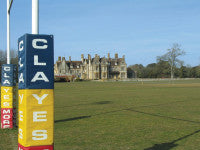 The main A350 between the Dorset market towns of Shaftesbury and Blandford Forum has to be one of the most picturesque roads in the county, if not the country. Dotted along its 13.5 mile length are double barrel villages with delightful names - Compton Abbas, Fontmell Magna, Sutton Waldron, Iwerne Courtney and Iwerne Minster. It is on the edge of the latter where Clayesmore Dorset sits in sixty-two acres of rural splendour. It is a combined Prep and Senior school with superb facilities, and caters for around 700 pupils.
The main A350 between the Dorset market towns of Shaftesbury and Blandford Forum has to be one of the most picturesque roads in the county, if not the country. Dotted along its 13.5 mile length are double barrel villages with delightful names - Compton Abbas, Fontmell Magna, Sutton Waldron, Iwerne Courtney and Iwerne Minster. It is on the edge of the latter where Clayesmore Dorset sits in sixty-two acres of rural splendour. It is a combined Prep and Senior school with superb facilities, and caters for around 700 pupils.
The school took over Iwerne Manor in 1933 (pronounced 'you-urn' and not 'I-were-knee' as many a grockle asks on finding themselves lost), having previously been based in Enfield, Pangbourne and Winchester. It sits very comfortably in its current surrounding.
Ray Norris has been head groundsman at Clayesmore for the past thirty-one years. "I've seen four headmasters and six bursars come and go in that time," he says with a smile.
Ray left school at the age of fifteen to take an apprenticeship at Rolls Royce Aero Engines in Watford, in his home county of Hertfordshire. "I wouldn't go back," he states. From there he moved to Poole in Dorset to work at Bluebird Caravans. "I hated working in a factory" he says, "so, when a vacancy for a trainee arborist at Poole Council was advertised, I applied for the job. I knew nothing whatsoever about trees so, in an effort to tell the difference between a hollyhock and holly, I bought the Collins Book of Trees and wandered around Poole Park before the interview trying to memorise as many of the latin names as I could." He got the job!
 "After a while, myself and a colleague set up a small tree surgery and landscaping company. When I moved to Iwerne Minster, one of my contracts was with Clayesmore. When the head groundsman retired, I was offered the job." That was in 1979 and Ray was twenty-eight years old.
"After a while, myself and a colleague set up a small tree surgery and landscaping company. When I moved to Iwerne Minster, one of my contracts was with Clayesmore. When the head groundsman retired, I was offered the job." That was in 1979 and Ray was twenty-eight years old.
"I had some experience through the landscape business, but it was a brave step to take. The previous incumbent's only cultural practice was to roll the whole site. It was compacted to hell!"
Ray knew that this 'flat is good' culture was not the way to continue so, true to form, he read books and attended training courses to fast track his knowledge.
"The whole site had a dead feeling," he says. "You know what I mean - the grass was green, but not the right green. It just looked lifeless. Fortunately, with a lot of aeration and some TLC, it wasn't long before it began to look and perform better."
I interviewed Ray in 'the pit', his affectionate term for his office, and one of the smallest I have seen. Two overweight 'approaching sixty year olds' certainly filled it! Crammed with reference books, trade catalogues and IT stuff, it's the hub of operations. "Computers and smartphones are tools that all groundstaff should be encouraged to use, there is a world of information out there just waiting to be accessed" he says, in an effort to assure me that his advancing years don't burden him.
He is not one to rest on his laurels. He is a Bachelor of Science, a degree he took with the Open University, and has added to that with a Diploma in Environmental Development. "I have a thirst for learning. Not only is it good for the soul, but it has given me respect with the bursar and the teaching staff."
"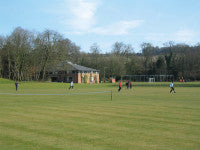 I've seen huge changes in our industry over the past thirty years. Once upon a time the IOG represented groundsmen, but I'm not impressed with the direction they have taken in recent years. It now appears remote and rather cold. I look back, with some affection, at the conferences of old, meeting colleagues and, most importantly, networking with them about the problems we face and the successes we have. It was three days well spent in my opinion. The one day' glitzy' bash they now put on is more like a school prize giving day. It just strikes me as back slapping and empire building!"
I've seen huge changes in our industry over the past thirty years. Once upon a time the IOG represented groundsmen, but I'm not impressed with the direction they have taken in recent years. It now appears remote and rather cold. I look back, with some affection, at the conferences of old, meeting colleagues and, most importantly, networking with them about the problems we face and the successes we have. It was three days well spent in my opinion. The one day' glitzy' bash they now put on is more like a school prize giving day. It just strikes me as back slapping and empire building!"
Ray is now on a roll. "I like nothing better than putting on a tie and jacket and visiting the shows and conferences. But, what I see all too much of is groundsmen and greenkeepers wandering about in scruffy, oily clothes. What sort of image does that project about our industry? Come on lads, smarten up. Even a logo'ed club polo shirt or bomber jacket and clean chinos presents a more professional image."
"I like what Pitchcare has done. They have certainly shaken up the industry for the good, in my opinion." It is here that Ray surprises me. Do you ever use the Pitchcare shop, I ask him? "No, he replies, I don't see you as a commercial organisation, rather a damn good reference library." What about the message board? "I read it" he says, "but haven't ever got involved. That said, I think it's great that we are able to interact like this. Cracking magazine too. I put it out in the workshop and all the staff read it."
Whilst Ray says the industry has become more professional, there is far more reliance on product these days. "I had a visit from a seed rep recently. He asked me when I last overseeded? I told him I had never overseeded, apart from the cricket tables obviously. He then repeated his question as if he couldn't believe it! All he was trying to do was get me to buy sixty or seventy of bags of seed to meet his targets. What sort of advice is that?"
"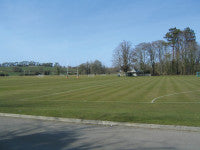 My philosophy is 'read the ground'. It's almost like a sixth sense. Any groundsman with any nous will understand their ground just by looking at it. Frequency and height of cut are all important. That will stimulate the grass better than anything else. That said, the coaches are requesting lower heights these days. It is something I am having to educate them about," he says with a smile.
My philosophy is 'read the ground'. It's almost like a sixth sense. Any groundsman with any nous will understand their ground just by looking at it. Frequency and height of cut are all important. That will stimulate the grass better than anything else. That said, the coaches are requesting lower heights these days. It is something I am having to educate them about," he says with a smile.
Ray has a staff of "five and a half" to help him. His deputy head is Peter Kunze and there are two further groundsmen, Eric Ball and Carl Humphries, and two gardeners, Rachel Watson and Steve Lucas. They have all been with Ray for over thirteen years, and all have the relevant certificates and qualifications. The 'half' is part-timer, Neil Tomlinson.
"They are a great bunch to work with," he states."In my absence Peter deputises seamlessly and Eric, our cricket specialist, does a fantastic job on the wickets. Carl likes nothing better than sitting on the triple all day. In truth, there is no demarcation, we all just get on with whatever is required. And Carl is a terrific mechanic. He has the ability to resurrect all but the most fatally wounded machine. He'll turn his hand to anything."
Any work that Carl cannot undertake, such as grinding, is carried out by Ben Johnson Garden Machinery Services of Shaftesbury, who also supply the smaller items of machinery, such as chainsaws, strimmers and blowers. Most of the larger machinery is purchased from New Forest Garden Machinery, the 'local' John Deere dealer. "I am a big fan of Deere," Ray says. "Their back-up is second to none." Other items are purchased direct from the manufacturers. Posts, nets and the like are sourced mainly through sports-e-quipment.co.uk who, Ray says, "also provide exemplary back-up and service."
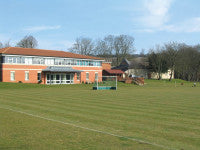 The school site is split into two by the entrance driveway. To the right, the prep school playing fields accommodate three permanent cricket squares and a temporary one, three rugby pitches, one grass hockey pitch, one football pitch and an athletics track. "It gets complicated," says Ray. "During the autumn we will turn some of the rugby pitches over to football and provide two extra grass hockey pitches. Cricket and hockey are really booming here, and the demand for pitches is high. The temporary cricket pitch is on the hockey surface. We are even having to add a fifth 'temporary' this summer. Remember, these are only for six and seven year olds using plastic balls but, even so, it is extra work for us. Not that I mind. The demand for sport can only good. What a start these kids get."
The school site is split into two by the entrance driveway. To the right, the prep school playing fields accommodate three permanent cricket squares and a temporary one, three rugby pitches, one grass hockey pitch, one football pitch and an athletics track. "It gets complicated," says Ray. "During the autumn we will turn some of the rugby pitches over to football and provide two extra grass hockey pitches. Cricket and hockey are really booming here, and the demand for pitches is high. The temporary cricket pitch is on the hockey surface. We are even having to add a fifth 'temporary' this summer. Remember, these are only for six and seven year olds using plastic balls but, even so, it is extra work for us. Not that I mind. The demand for sport can only good. What a start these kids get."
The main prep school cricket square has thirteen strips, all marked out at twenty-one yards, with the exception of the end two, which are twenty-two yards for senior matches. These are used by clubs hiring the facilities. The old pavilion is currently getting a new roof.
The senior school facilities accommodate, at various times, four rugby pitches, two football pitches, two grass hockey pitches, an athletics track and one pitch that is left fallow for the cricket outfield during the winter.
The two senior cricket tables are used by Dorset representative sides from as young as under 10s to the over 50s.
"When I came here, the main cricket square was just cut out of the field. It played okay, but only okay" says Ray. "So, I undertook a programme of hollow coring to introduce some loam - we used Mendip initially but have now moved on to Banbury. It took fifteen years to get the wicket how I wanted it to perform, but now it offers all the intricacies a cricket wicket should."
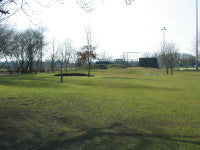 "Interestingly, the two sides of the road have distinctly different soil types," says Ray. The prep fields are on a very free draining sandy soil, whilst the senior pitches are on chalk over clay. This is where my 'read the ground' philosophy really comes into its own as they often require completely differently maintenance, even on a weekly basis. It is also why no sales rep can ever fully understand my grounds."
"Interestingly, the two sides of the road have distinctly different soil types," says Ray. The prep fields are on a very free draining sandy soil, whilst the senior pitches are on chalk over clay. This is where my 'read the ground' philosophy really comes into its own as they often require completely differently maintenance, even on a weekly basis. It is also why no sales rep can ever fully understand my grounds."
In addition to all the grass pitches, the team also look after six tarmac tennis courts, a full size synthetic hockey pitch, which offers twelve tennis courts in the summer, a one hectare lake, the formal gardens and, just down the road, the grounds of Devine House, the old village rectory which is now used as a boarding house.
There is also one golf hole - a par 3 with a couple of bunkers and tee mats at various distances, that is offered as a bit of extra entertainment for the pupils and the various holiday time 'camp' visitors. Behind that is an assault course used by the local Combined Cadet Force for training.
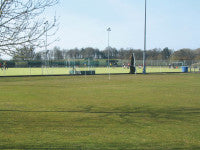 When the pre-prep school building was built, Ray and his team installed all the boundary fencing and constructed the adventure playground.
When the pre-prep school building was built, Ray and his team installed all the boundary fencing and constructed the adventure playground.
A new artificial pitch is being installed shortly. The old one has lasted fifteen years, with Ray being able to extend its life courtesy of a SISIS Litamina HLL1200, purchased last November.
With the school being so close to a main road, I ask about security, especially as, just over the hill, the area hosts the annual Dorset Steam Fair, the largest in the country, when locals are regularly relieved of the contents of their garden shed!
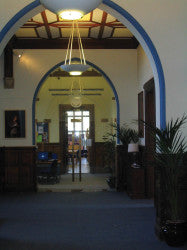 "We have CCTV cameras, steel shutters and various other deterents" says Ray.
"We have CCTV cameras, steel shutters and various other deterents" says Ray.
Ray has earmarked a site for a new workshop which, he hopes, will be completed before he retires! It will include new washdown facilities, to be installed by Course Care, more security and a slightly larger 'pit'.
As we walk the grounds, it is clear that Ray and his team work to the very highest standards - and remember, this is mid March, following the worse winter in three decades. "I feel very privileged to work here" he says. "I see it as my duty to show the school in the best possible light. The grounds are the shop window for the school and create an immediate impression with visitors."
We head for coffee in the Main House - I was promised cake, but never got any - where the new bursar and a couple of teachers are finishing the day with a caffeine intake. There is immediate banter between them and Ray, a clear sign of mutual respect.
Before I leave, Ray has one more thing to show me. It is a Michael Caine moment. I am led to a rather grand corridor where three rather less than splendid ceiling lights hang down. It was here that the infamous Only Fools And Horses 'chandelier' sketch was filmed. Now, not many people know that.

